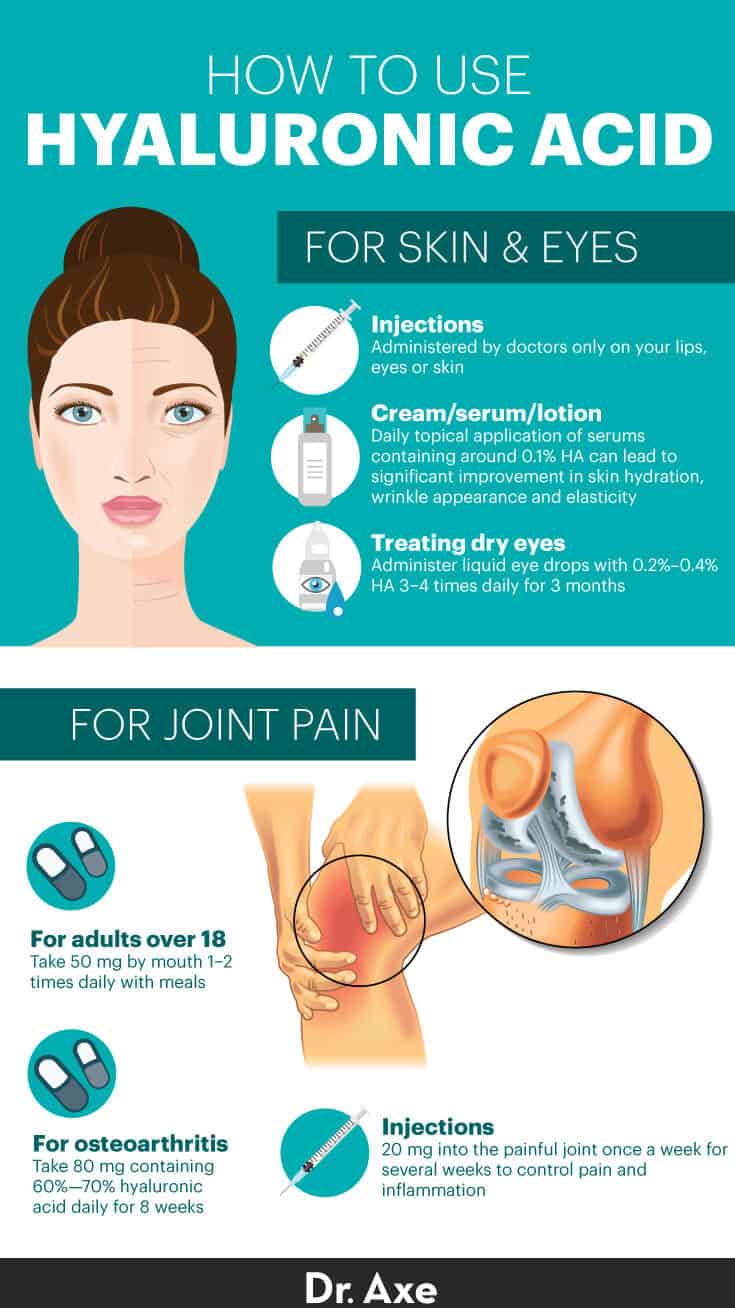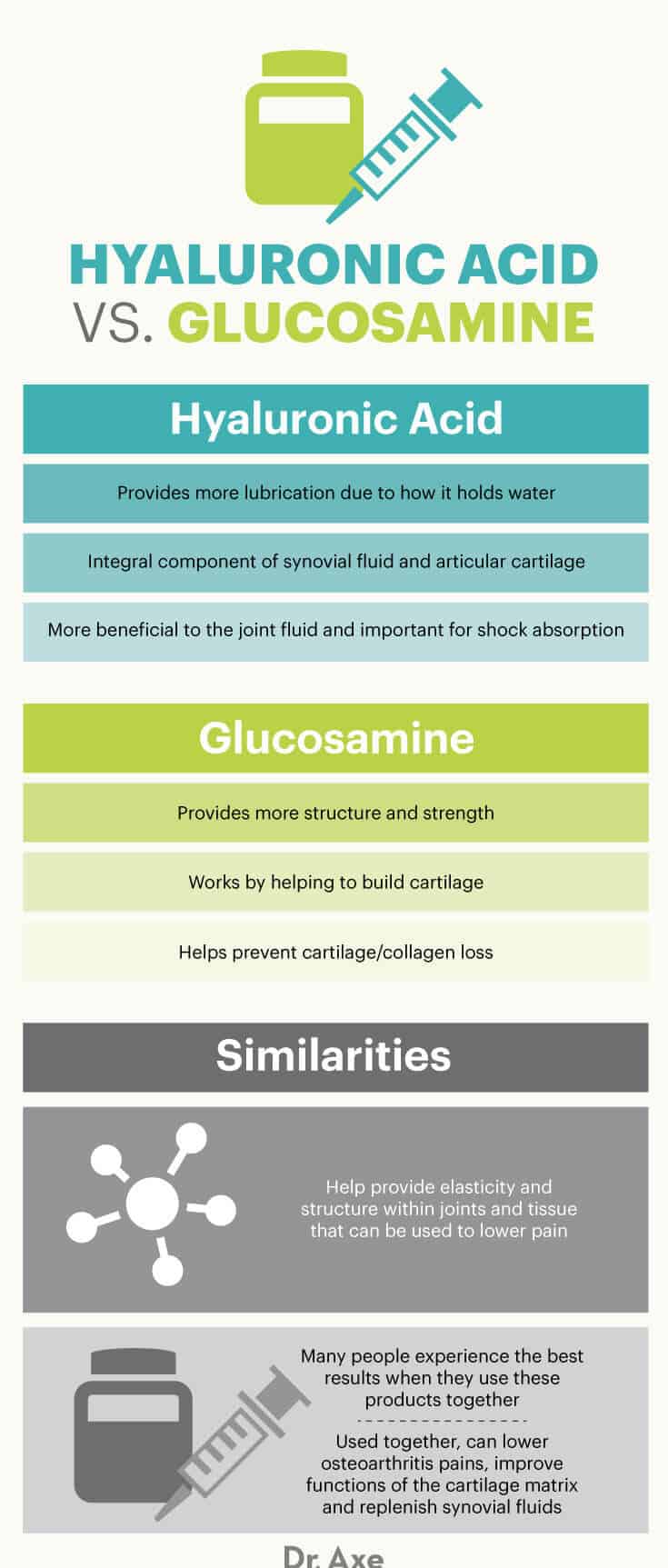
Many people spend countless hours using harmful beauty products to keep their skin looking vibrant and young. But there’s a better way. Hyaluronic acid can keep your skin glowing, and it also benefits your joints — all without the harmful side effects of toxic skin products.
Hyaluronic acid, also called hyaluronan, is often recommended by dermatologists and other physicians for its ability to improve skin’s texture and appearance, along with reducing joint pain and other symptoms associated with aging. Hyaluronic acid is probably most well-known for its inclusion in pricey anti-aging skin serums, but you’ll also find it joint-supporting formulas, cold sore treatments, eye drops and lip balms.
What Is Hyaluronic Acid?
So what is hyaluronic acid exactly, and how does it work? Hyaluronic acid is a lubricating, clear substance that’s produced by the body naturally. In the human body, hyaluronic acid is found in the greatest concentrations in the skin, inside joints, within the eye sockets and in other tissues where it helps retain collagen, increase moisture, and provide elasticity and flexibility.
Hyaluronic acid was originally derived from rooster comb. While that form is still available, it’s better to use hyaluronic acid that’s made from a lab-created fermentation process. It’s sold both in liquid and powder form. While liquid forms contain a preservative and perhaps even propylene gylcol and alcohol, powder does not and is preferable.
Today, hyaluronic acid is incorporated into different anti-aging beauty and health care products — you can now find hyaluronic acid lotions, creams, serums and supplements sold in health food stores. There’s a good chance your dermatologist even offers hyaluronic acid in injection form.
Hyaluronic acid is also a naturally occurring ingredient in bone broth, which is why adding more bone broth or protein powder made from bone broth to your diet can automatically increase your hyaluronic acid intake.
When applied topically, hyaluronic acid cannot be absorbed. Sodium hyaluronate, however, is the salt of hyaluronic acid. Because it is a much lower molecular size, sodium hyaluronate can penetrate the skin when applied topically, and thus appears in creams and other potions.
The biggest advantage that hyaluronic acid has to offer is that it has a very high capacity for retaining water, whether on the skin, in the eyes or within soft tissue. Hyaluronic acid is considered a glycosaminoglycan, which gives it its capacity to hold a large volume of water along with its high viscosity.
Throughout the body, hyaluronic acid is distributed in many different tissues, especially in the skin, where it provides moisture and structure. The skin accounts for about half of all the hyaluronic acid found in the entire body.
Other body parts where hyaluronic acid is concentrated include tendons and joints, the membranes of the eyes, the umbilical cord, synovial fluid, skeletal tissues, heart valves, lungs, aorta and prostate. Hyaluronic acid is basically a very long link of carbohydrate molecules bound together that hold water and therefore allow for fluid movement and pressure absorption.
Over the past two decades, emerging research has shown that beneficial functions of hyaluronic acid include hydration, lubrication of joints, a space-filling capacity within tissue and between cells, building the framework through which cells migrate, repairing tissue and wounds, regulating activation of inflammatory cells (inflammation), enhancing immune responses, repairing injury of fibroblasts, and maintaining skin’s epithelial cells.
Related: Alpha Arbutin Benefits for Skin + How to Use It
Health Benefits
1. Hydrates Dry, Aged Skin
Yes, hyaluronic acid is a hydrator. Many people report that their skin feels “dewier,” the bags under their eyes become lighter and their skin texture is smoother after applying serums containing hyaluronic acid.
The primary way in which hyaluronic acid helps improve appearance of “chronoaged skin” (skin aged due to sun exposure) is by reducing water loss. In fact, one reason that hormone replacement treatments sometimes cause the skin to look more youthful and less sun-damaged is because they increase the skin’s hyaluronic acid concentration.
Dryness, dandruff, drooping eyes or lips, and sagginess are associated with aging skin because as we get older molecules in our skin lose some of their ability to bind and retain water. This not only causes dryness, but also decreases skin’s volume. Skin aging is triggered by both intrinsic and extrinsic aging, meaning daily environmental exposure to pollutants and UV light, along with the “the normal process of aging.” Studies show there are multiple sites in the skin involved in the control of hyaluronic acid synthesis, deposition, cell and protein association and degradation.
Researchers have found that stratum corneum dryness caused from prolonged sun exposure plays an important role in wrinkle formation. It’s now been shown that wrinkles and fine lines are usually also more visible in low humidity compared to high humidity environments because they further reduce the water-holding capacity and elasticity of the skin.
Hyaluronic acid can help naturally reduce signs of aging by decreasing the “epidermis water loss” associated with sun exposure, skin dryness or flakiness.
Related: Phytoceramides for Smoother, Healthier, More Hydrated Skin
2. Helps Reduce Wrinkles
Within weeks of using a topical hyaluronic acid product, you may see a visible increase in skin surface hydration. Although most research shows hyaluronic acid may take six weeks or more to improve skin’s appearance, some studies have found that anti-wrinkle hyaluronic acid serums and eye creams can sometimes start to work within just two to four weeks of use.
For more substantial anti-aging results, dermatologists now use prescription injections or formulas containing hyaluronic acids (including Juvéderm Ultra Plus or Allergan) over the course of several months to reduce lip and eye sagginess.
Results from a 2014 double-blind, randomized clinical trial that appeared in the Journal of Cosmetic Dermatology showed that products containing hyaluronic acid effectively decreased the appearance of wrinkles and reduced skin sagging within 30 days of consistent use. Some study participants also reported experiencing fuller lips and increased cheek volume by the end of one month (two traits associated with having a youthful appearance).
The trial was carried out on 40 adult females who showed mild to moderate clinical signs of skin aging prior to the study, including decreased skin volume and alterations in the skin’s surface. After either applying a product called Fillerina (which contains six forms of hyaluronic acid) or a placebo product, results were measured after three hours and then seven, 14 and 30 days later.
READ RELATED: Italian man, 36, becomes first person to simultaneously test positive for monkeypox, Covid and HIV
Researchers found that after 30 days (and some starting after 14 days), those using Fillerina showed significant “improvements in facial contours and volumes” compared to the placebo group, and to the baseline measurements. The active treatment group experienced reductions in sagging of both the face and the cheekbones contours, improved lip volume, and decreased wrinkle depth and volume, while the placebo group saw no such improvements.
A separate study published in the The Journal of Clinical and Aesthetic Dermatology evaluated a new topical low molecular nano-hyaluronic acid preparation for wrinkles, skin hydration and skin elasticity in humans. Thirty-three women with an average age of 45 were studied over eight weeks to measure its anti-wrinkle efficacy of a new nano-hyaluronic acid.
Study results show statistically significant moisturizing effect, finer skin texture and improved skin elasticity. In conclusion, “The new nano-hyaluronic acid clearly demonstrated a significant benefit in decreasing the depth of wrinkles (up to 40 percent), and skin hydration (up to 96 percent) and skin firmness and elasticity were significantly enhanced (up to 55 percent) at the end of eight weeks.”
3. Sores, Sunburn and Wound Repair
Aside from lowering the appearance of wrinkles and dryness, hyaluronic acid is beneficial for treating cold sores and mouth sores, ulcers, wounds, bites and burns due to how it keeps damaged tissue moist. Tissue repair benefits also include sunburn relief. Many cold sore treatments for the lips and mouth contain hyaluronic acid gel to speed up the healing process and prevent cracking or bleeding.
Hyaluronic acid is part of the structural component of the mouth and the lips, which are made up of connective tissues made partly from collagen and water. Collagen and hyaluronic acid help give lips their structure and shape. Because hyaluronic acid binds to water, it hydrates the skin and tissues within the mouth/lips and keeps skin junctions tight, helps bring nutrients to damaged tissues, controls inflammation and helps fluids carry out waste.
4. Lubricates Achy Joints
Hyaluronic acid is found in all bones, connecting tissue, joints, tendons and cartilage structures throughout the body — especially a type called hyaline cartilage, which covers the ends of bones and provides cushioning. Because it helps buffer bones and provides resistance to wear and tear, hyaluronic acid is useful for lowering pains and tenderness associated with degenerative joint diseases.
It’s also found in another important part of our joints called the synovial membrane, which forms a coating over two articulating bones and produces synovial fluid. Synovial fluid is a “viscous fluid” that helps joints absorb shock, remain elastic and carry nutrients to cartilage.
Hyaluronic acid is now a popular substance used in supplements for treating osteoarthritis pain and injuries. It’s also been approved by the FDA for treatment of osteoarthritis when administered in relatively high doses through injections given by a health care provider.
Some research shows that lower doses can also be effective for reducing joint stiffness and chronic pain, although results seem to vary. The types of joint pains most commonly treated with hyaluronic acid include those of the elbows and knees.
5. Helps Reduce Dry Eyes and Eye Discomfort
The fluid inside the eye socket (called the vitreous humor) is composed almost completely of hyaluronic acid. Hyaluronic acid eye drops (such as the brand Hyalistil) can help relieve chronic dry eyes by replenishing moisture within the eye socket, helping with tear production and restoring fluid balance. Some studies have also found that hyaluronic acid helps suppress oxidative damage caused by UVB light within the cornea.
Doctors commonly use lubricating hyaluronic acid formulas to treat eye injuries and disorders, including cataracts, especially at the time before or after surgery when the eyes are most sensitive and dry. Hyaluronic acid drops can be beneficial during eye surgery or recoveries, including after cataract removal, corneal transplant or repair of a detached retina.
6. Protects Against Inflammatory Bowel Disease
Naturally occurring hyaluronic acid, like that produced by your body and found naturally in chicken collagen, is present in large particles that function in the gut that may help protect from or repair inflammatory bowel diseases like Crohn’s and ulcerative colitis.
Overuse of isolated hyaluronic acid, particles of which are smaller than naturally occurring ones, can sometimes result in increased inflammation in the gut. However, adding hyaluronic acid-rich foods and supplements in your diet, such as bone broth or protein powder made from bone broth, can help to encourage the gastrointestinal system’s natural healing process and potentially protect from leaky gut syndrome.
Related: Hydrochloric Acid: Stomach Acid that Defends Against GERD, Candida & Leaky Gut
Hyaluronic Acid vs. Glucosamine
- Like hyaluronic acid, glucosamine helps provide elasticity and structure within joints and tissue that can be used to lower pain.
- The primary difference between the two is that hyaluronic acid provides more lubrication due to how it holds water, while glucosamine provides more structure and strength.
- Hyaluronic acid is an integral component of synovial fluid and articular cartilage, where as glucosamine (especially when used with chondroitin sulfate) works by helping build cartilage. Basically, hyaluronic acid is more beneficial to the joint fluid and important for shock absorption, while glucosamine helps prevent cartilage/collagen loss.
- Many people experience the best results when they use these products together. It’s even been found that glucosamine increases hyaluronic acid production.
- Some anti-aging formulas contain several joint-supporting substances in addition to hyaluronic acid and glucosamine, such as manganese sulfate. Used together, these can all be effective for lowering osteoarthritis pains, improving functions of the cartilage matrix and replenishing synovial fluids.
Uses
Hyaluronic acid for your skin and eyes
- Hyaluronic acid injections: These are administered by doctors only, so talk a dermatologist about recommendations if you’re interested in using hyaluronic acid on your lips, eyes or skin.
- Hyaluronic acid cream/serum/lotion: Different brands contain varying concentrations and types of hyaluronic acid molecules. The most effective types have more than one size of hyaluronic acid molecules, since various sizes work in different ways. Studies have found that daily topical application of serums containing around 0.1 percent hyaluronic acid can lead to significant improvement in skin hydration, wrinkle appearance and elasticity.
- For treating dry eye: hyaluronic acid can be administered in liquid eye drop form three to four times daily for three months. Look for a concentration of hyaluronic acid around 0.2 percent to 0.4 percent, but also make sure to always read directions.
Hyaluronic acid supplements for joint pain
- According to the Arthritis Foundation, there are now several hyaluronic acid treatments approved for knee osteoarthritis in the U.S.: Hyalgan, Orthovisc, Supartz and Synvisc. These are often made from rooster or chicken combs and sometimes bacteria.
- In adults over age 18: 50 milligrams of hyaluronic acid can be been taken by mouth one to two times daily with meals.
- For people with osteoarthritis, research shows that 80 milligrams (containing 60 percent to 70 percent hyaluronic acid) taken daily for eight weeks helps relieve symptoms best.
- You can also talk to your doctor about hyaluronic acid injections. Some perform direct injections of about 20 milligrams into the painful joint once a week for several weeks to control pain and inflammation.

Precautions and Possible Side Effects
The FDA reports that hyaluronic acid products are normally safe when taken by mouth or used topically on the skin/mouth. Hyaluronic acid supplements and injections should be avoided by pregnant women or those who are breast-feeding, since it seems to be able to linger in breast milk and might be capable of negatively affecting a developing fetus or baby.
The FDA has approved the use of hyaluronic acid dermal fillers (usually in people over the age of 21) that have temporary effects. They are not permanent because they contain materials that are absorbed by the body over time, which does not seem to be harmful.
Most research suggests that hyaluronic acid dermal fillers in the treatment of facial wrinkles, folds and lines is generally safe if patients follow their doctor’s instructions afterwards. Some temporary side effects after receiving these injections are possible, such as mild inflammatory reactions and sensitivity to sunlight, but these tend to clear up within 2–7 days.
In very rare cases more serious side effects have occurred, including vascular changes (damage to the eyes due to blockage of blood vessels) and changes in eyesight.
Side effects of hyaluronic acid injections are more common when someone receives permanent fillers. It’s important that patients follow their doctor’s instructions after treatments, including avoiding wearing makeup for 24 hours after the injection, avoiding direct exposure to the sun or excessive heat for several days, using SPF 30 sunscreen daily and avoiding sports/vigorous activities during the week of the application. This helps limit the risk for inflammation and other adverse reactions.
When there are complications from hyaluronic acid filler injections, hyaluronidase is sometimes used to reverse the effects of the fillers. Hyaluronidases are enzymes that are able to break down HA.
Prescription and commercial products containing hyaluronic acid are usually made from either bacteria created within a lab or prepared from bird protein and cartilage. People with allergies to eggs or feathers should not use these products since they can trigger reactions and even bleeding. If you have allergies, always read ingredients and dosage directions so you’re not unsure of the type of hyaluronic acid you’re getting.
People using medications that affect blood clotting, such as warfarin (Coumadin) or aspirin, shouldn’t use HAhyaluronic acidsupplements since this can increase risk of bleeding.
Final Thoughts
- Hyaluronic acid is a lubricating fluid that’s naturally found in the skin, eyes, joints, fluid and connective tissue.
- Because hyaluronic acid has a very high capacity for holding water, it’s used in supplement, lotion, eye drop or serum form to give structure and moisture to damaged tissue.
- Certain types of hyaluronic acid also have anti-inflammatory properties and help reverse collagen/cartilage loss.
- Benefits of using hyaluronic acid including firming aging skin, reducing achy joints, moisturizing wounds and rewetting dry eyes.
Source:








